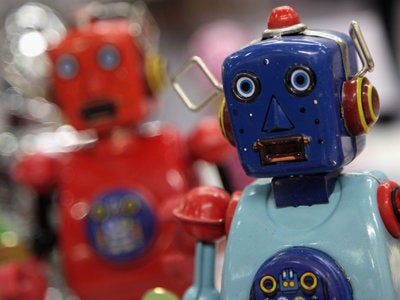
Two weeks ago, the lower bowl of the Georgia Dome in Atlanta was filled with screaming fanatics of a very different sort. What is normally hallowed ground for professional football players was transformed for three days into a playground for bright, young students competing in the FIRST Robotics international championships. The adoring and enthusiastic crowds weren't there to cheer on the athletic feats Matt Ryan and the rest of the Atlanta Falcons; instead, they were pouring their support behind groups of middle and high school students who have accomplished extraordinary things with their brains.
Students get excited about FIRST, excited enough to dress up in costumes and fly across the country to shout cheers from the stands of the Georgia Dome. Speaking with them, you can easily spot the source of their excitement: the understanding that being smart and working hard can translate into real world accomplishments. "Before I started building robots, I didn't really know how to actually do anything--I took classes in math and science, but all you learn in class is how to do homework or how to do well on tests. In the classroom, I didn't see a purpose for what I was doing," said Daniel Calvo, a young FIRST alumnus now working as an engineer for Northrop Grumman. "But when you have to build a robot, especially one as complicated as a FIRST robot, you need to actually apply what you learn in your math and science classes. A teacher can tell you that you did a problem right on a test, and you just have to believe them--but with robotics, you see the results right in front of you. Realizing that what I learned in class would actually affect the outcome of how well my robot performed became my main catalyst for doing well in school, and it's what made me realize that I actually was learning something important. Without a doubt, that's why I'm an engineer today. Now, I'm serving as a mentor for my old team, because I'm hoping other students will be able to say the same."
As Calvo indicates, the robots themselves are something to behold. The oldest and most advanced students each build refrigerator-sized bots, full of custom made parts often made by the students themselves in the machine shops of their schools, local universities, or sponsoring companies. They feature automated controls, a variety of sensors, and a wide range of clever systems designed to achieve the basic premise of the FIRST matches--launching basketball-sized globes into opponents' targets and defending their own. If you locked me in a workshop for a hundred years, I don't think that I could build a robot half as impressive as what these students churn out in about two months.
But the competition isn't just about the robots. The students are also are trained in the ways of "gracious professionalism"--essentially, sportsmanship carried beyond the world of sports (and not just limited to men). In every round of the competition, students are paired with two other teams, and find ways to work together on the field of play. But even before that, the students have been engaged in outreach and educational activities to get younger students excited about robotics and technology. Many of the older students are even going out and proactively fundraising to start new teams for the younger students--establishing 'farm teams' to increase their own talent pool.
"Our mission is about more than building robots; we are working to inspire and change a culture," said Dean Kamen, FIRST founder and an extraordinary inventor in his own right. "We need more innovative thinkers to help solve a number of increasingly complex problems in the world. I am confident there is a bright future ahead - I caught a glimpse of it at the FIRST Championship." This will come as welcome news to those weary of reading a non-stop parade of terrifying headlines. The news may be especially bright for one region of the country particularly beleaguered in recent times: three of the six finalists, and one member of the winning three-team group, were from the state of Michigan.
It's clear that these students have promising careers in front of them, and FIRST provides them plenty of ways to follow up on their efforts. A "scholarship row" at the Finals features nearly $10 million in scholarships specifically for FIRST graduates, and a number of engineering firms and agencies are there to tell the students about future career opportunity. I was there to talk to the students about the Google Lunar X PRIZE, a competition for privately funded robotics missions to the Moon. With $30,000,000 in prizes, the Google Lunar X PRIZE is the largest international incentive prize ever offered, and has correspondingly difficult requirements. But the students, especially the ones who had just finished a lunar-themed competition for the oldest students--were undaunted. I remember telling one student from the FIRST Junior LEGO league, the youngest age bracket at FIRST, about the prize rules. "Wait," he told me. "All I have to do is land a robot on the Moon, make it move around a bit, and send back pictures?" I told him that he had it right. "Jeez," he said. "That's easy!"
With kids like these, the future will always look bright, no matter how dark the present seems. What the world really needs now is a generation of fresh, energized, savvy champions for change, and that's exactly what today's youth are.
